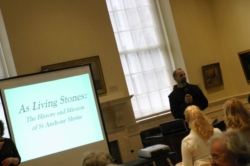Lecture series closes second year with talk on St. Anthony Shrine
BOSTON -- The Christ Speaks in the City lecture series closed its second year May 15 with a talk about another Catholic resource located downtown -- St. Anthony Shrine on Arch Street.
The lunchtime speaker series, sponsored by the Archdiocese of Boston’s Vocations Office, began in fall 2006 as a way to invite young adults working downtown to find time for God in their busy lives. Four talks are held at the Old Statehouse each fall and again in the spring.
The 16th lecture, held May 15, was led by Brother Hugh MacSherry, OFM, a friar at the Arch Street Shrine and intern for the Deaf Apostolate. His talk was entitled, “As Living Stones: the History and the Mission of St. Anthony Shrine.”
Brother Hugh spoke about the history of the shrine building as well as the history of its worshippers who are the community’s “living stones.”
In the 1940s diocesan priests opened the small St. Thomas More Chapel on Franklin Street to be a convenient place for prayer and confession. During the Christmas and Lenten seasons, they had long lines for confession and called on the Franciscans to assist them with the sacrament in 1945, he told those gathered.
One particular friar heard confessions for a couple of hours, Brother Hugh said. “By the week’s end 700 people had sought out that friar. More friars and more hours resulted in more people seeking confession.”
That year, Cardinal Richard Cushing gave permission for the Franciscans to purchase a building around the corner from St. Thomas More. The building at 103 Arch Street was meant to be a temporary shrine while a larger shrine at 100 Arch Street was built. It is now a residence for retired friars, he said.
The temporary shrine opened on Ash Wednesday in 1947, and 50,000 people received ashes that day. The friars offered regular Masses, confession and pastoral counseling at that location and lived in one big room in the basement with curtains between their cots, he said. By 1950, daily Mass attendance reached 1,500 and 5,000 people attended the St. Anthony devotions every Tuesday.
“Despite two chapels, the larger of which held 100 people, and bringing in extra friars at peak times, the shrine needed more,” said Brother Hugh. “The first shrine started because so many people were lining up for confession. It was obvious from these lines and the first day’s attendance at Ash Wednesday services that the friars and Archbishop Cushing had been right, that they needed more space.”
At the second, larger shrine, dedicated in 1955, both chapels held 800 people each, and the auditorium was designed to be used as a chapel as well, he said.
The sacramental ministry of the shrine was and remains its main focus. In the beginning, Sunday Masses were held at 1:30 a.m., 2:30 a.m., 3:15 a.m., 5:30 a.m. and every 45 minutes after until 12:30 p.m., and there were Catholic catechism and inquiry classes, an information center and many times for confession, he said.
“The sacraments characterize the Catholic faith, spirituality and work,” Brother Hugh said.
In the 1960s and 1970s, the shrine attempted to respond to the changes instituted by the Second Vatican Council. As part of that, the shrine began to invite lay people to more active participation and reached out to people in the community who were in need, he explained.
In the 1980s, the friars opened St. Francis House, which at the time was the only place that hot meals were served every day of the week, he said.
Now, the shrine also offers counseling and support groups for recovering addicts and reaches out to children, people living on the streets, the sick and senior citizens. St. Anthony Shrine’s mission is to encourage everyone, no matter their circumstances, to follow Christ, he said.
“We meet people where they are. I am going to admit to you that I am a terrible sinner and yet God is calling me to be part of his Church,” Brother Hugh added.
Tanya Skypeck, a young adult who works downtown, attended the lecture and told The Pilot that she visits St. Anthony’s for daily Mass.
“I remember my first Ash Wednesday going in there and just seeing the stream of people all day,” she said. “There was this desire for people to have that mark on their forehead.”
Skypeck said she found it interesting that the Ash Wednesday crowds of the past were part of the reason the large shrine with two chapels was built. The shrine has served and continues to serve “a great purpose.”
She added that she is grateful for the gift to attend daily Mass and receive the Eucharist. The rigorous Mass schedule means she cannot “make excuses” for not attending.



















